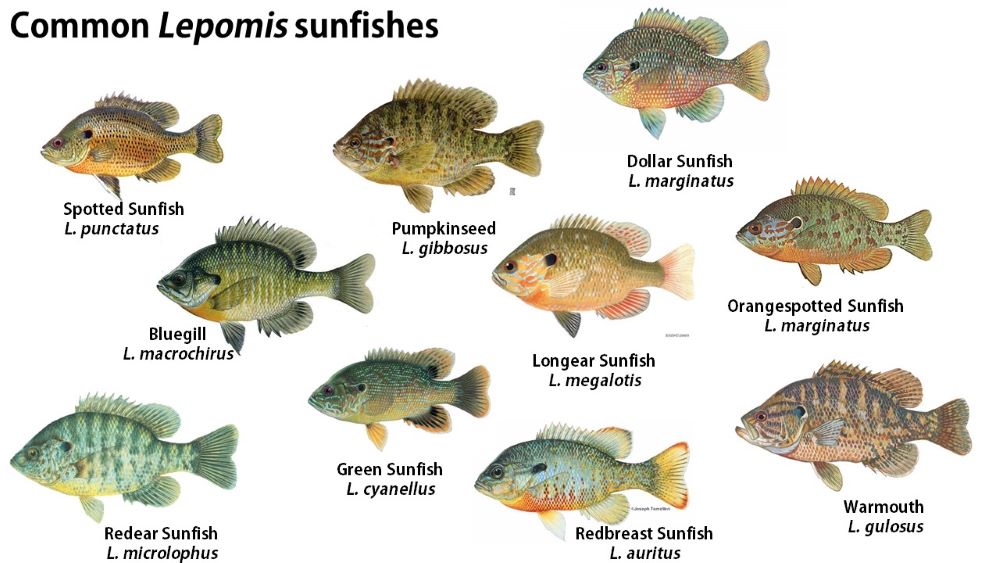
In the vast expanse of our world’s oceans and freshwater bodies, a fascinating array of marine life thrives, each species boasting its unique characteristics and adaptations. Among these captivating creatures is the sunfish, a group encompassing various species known for their peculiar appearance and intriguing behaviors. From the enigmatic Mola mola to the elusive ocean sunfishes, these gentle giants have captured the curiosity of scientists and enthusiasts alike.
In this comprehensive guide, we delve into the realm of sunfish identification, shedding light on the distinguishing features, habitats, and behaviors of these remarkable marine inhabitants. Whether you’re a seasoned marine biologist, an avid angler, or simply an enthusiast with a thirst for knowledge, join us on a journey to unravel the mysteries of sunfish and gain a deeper understanding of these mesmerizing creatures.
The Diverse World of Sunfish Species
Within the family Molidae, commonly referred to as sunfish, exists a diverse array of species, each possessing its unique characteristics and adaptations. From the awe-inspiring ocean sunfish (Mola mola) to the diminutive southern sunfish (Ranzania laevis), these creatures exhibit remarkable diversity in size, shape, and habitat preferences.
Ocean Sunfish (Mola mola): One of the most iconic members of the sunfish family, the ocean sunfish, also known as the mola mola, is renowned for its massive size and peculiar appearance. With a flattened body that can reach lengths of up to 3 meters and weigh over 2,000 kilograms, the ocean sunfish holds the title of being the heaviest bony fish in the world. Its distinctive circular shape, truncated tail fin, and rough skin adorned with mottled patterns make it easily recognizable to seasoned marine enthusiasts.
Southern Sunfish (Ranzania laevis): In stark contrast to the ocean sunfish, the southern sunfish, or slender mola, presents a more slender and elongated body form. Measuring typically around 1 meter in length, the southern sunfish boasts a streamlined profile suited for swift swimming in open waters. Its vibrant coloration, characterized by shades of silver, blue, and yellow, adds to its allure, making it a sought-after sight for divers and snorkelers in tropical and subtropical regions.
Sharptail Mola (Masturus lanceolatus): Among the lesser-known members of the sunfish family is the sharptail mola, distinguished by its elongated body and prominent, sharply pointed tail fin. Despite its elusive nature and sparse sightings, this species plays a vital role in marine ecosystems, contributing to the delicate balance of oceanic food webs.
Hoodwinker Sunfish (Mola tecta): Discovered relatively recently in 2017, the hoodwinker sunfish took the scientific community by surprise with its unexpected presence in temperate waters across the Southern Hemisphere. With its modest size and unassuming appearance compared to its larger relatives, the hoodwinker sunfish continues to intrigue researchers, raising questions about its distribution, behavior, and ecological role.
Other Sunfish Species: In addition to these prominent members, the sunfish family encompasses several other species, each with its own distinct traits and adaptations. From the slender molas (Ranzania spp.) to the elusive masturus (Masturus spp.), exploring the rich diversity of sunfish species offers a glimpse into the marvels of marine evolution and biodiversity.
Ecology and Habitat Preferences
Understanding the ecology and habitat preferences of sunfish species is crucial for their conservation and management. Sunfishes are primarily pelagic, meaning they inhabit open ocean waters, but their distribution and behavior vary significantly between species.
Ocean Sunfish (Mola mola): Ocean sunfish are known for their extensive range, spanning both temperate and tropical oceans worldwide. They are frequently observed near the ocean surface, basking in the sun to regulate their body temperature. Despite their massive size, ocean sunfish are agile swimmers, capable of diving to considerable depths in pursuit of their prey, which primarily consists of jellyfish, zooplankton, and small fish.
Southern Sunfish (Ranzania laevis): Southern sunfishes prefer warm, tropical and subtropical waters, often found in the Atlantic, Indian, and Pacific Oceans. They tend to inhabit offshore areas, particularly around reefs and oceanic islands, where they feed on a variety of small fish, crustaceans, and planktonic organisms. While less frequently encountered than ocean sunfish, southern sunfishes play a vital role in maintaining the health of coral reef ecosystems through their foraging activities.
Sharptail Mola (Masturus lanceolatus): Sharptail molas are elusive inhabitants of deep oceanic waters, often found in offshore pelagic environments. Their distribution is poorly understood due to limited sightings, but they are believed to inhabit temperate and tropical seas worldwide. Sharptail molas are thought to feed primarily on gelatinous zooplankton, using their streamlined bodies and sharp tail fins to navigate the water column in search of prey.
Hoodwinker Sunfish (Mola tecta): Hoodwinker sunfishes have been documented in temperate waters of the Southern Hemisphere, including off the coasts of Australia, New Zealand, South Africa, and Chile. Unlike their larger relatives, hoodwinker sunfishes exhibit a more cryptic behavior, often remaining hidden beneath the surface or in deep oceanic waters. Their diet likely consists of a variety of small pelagic organisms, but further research is needed to elucidate their feeding habits and ecological role.
Other Sunfish Species: While specific ecological requirements vary among sunfish species, they share a common dependence on healthy marine ecosystems for their survival. Conservation efforts aimed at protecting key habitats, mitigating human-induced threats such as overfishing and habitat degradation, and promoting sustainable fisheries management are essential for safeguarding the future of sunfish populations worldwide.
Behavior and Life Cycle
Sunfish species exhibit fascinating behaviors and life cycles that contribute to their unique ecological roles and evolutionary success.
Ocean Sunfish (Mola mola): Ocean sunfish are known for their leisurely swimming patterns near the ocean surface, where they often bask in the sunlight to regulate their body temperature. Despite their sluggish appearance, they are capable of swift movements and can dive to considerable depths in search of prey. Mating behavior in ocean sunfish is not well-documented, but they are known to produce a vast number of eggs, with a single female capable of releasing millions of tiny eggs into the water column. The larvae undergo a pelagic phase before settling into their adult habitats.
Southern Sunfish (Ranzania laevis): Southern sunfishes are more elusive than their larger relatives, often found in deeper offshore waters. They exhibit similar basking behavior near the surface and are known for their swift swimming capabilities. Mating and reproductive behaviors in southern sunfishes are poorly understood due to limited observations, but they are believed to follow a similar reproductive strategy to other sunfish species, releasing buoyant eggs into the water column for fertilization.
Sharptail Mola (Masturus lanceolatus): Sharptail molas are rarely encountered in the wild, making observations of their behavior and life cycle challenging. Like other sunfish species, they likely engage in basking behavior near the surface and exhibit pelagic larval stages before settling into their adult habitats. The mating behavior of sharptail molas remains a mystery, highlighting the need for further research to unravel the secrets of these elusive creatures.
Hoodwinker Sunfish (Mola tecta): Hoodwinker sunfishes are relatively understudied compared to other sunfish species, with limited information available on their behavior and life cycle. Their cryptic nature and deep-sea habitats make them difficult to observe in their natural environment. Research efforts aimed at uncovering the mating behavior, reproductive biology, and ontogeny of hoodwinker sunfishes are essential for gaining insights into their ecological role and conservation needs.
Other Sunfish Species: While specific behaviors and life cycle details may vary among sunfish species, they share common adaptations and strategies for survival in their respective habitats. Continued research and monitoring efforts are essential for advancing our understanding of sunfish biology and informing effective conservation measures to protect these intriguing marine creatures.
Conservation Challenges and Efforts
Despite their ecological importance and cultural significance, sunfish species face various conservation challenges due to human activities and environmental threats.
Overfishing: Sunfish populations are susceptible to overfishing due to their slow growth rates, low reproductive rates, and susceptibility to bycatch in commercial fisheries. Targeted fisheries for sunfish meat, particularly in some Asian countries, pose a significant threat to certain species, including the ocean sunfish. Bycatch in longline and gillnet fisheries targeting other species also contributes to sunfish mortality.
Habitat Degradation: Destruction and degradation of marine habitats, such as coral reefs, seagrass beds, and pelagic feeding grounds, pose significant threats to sunfish populations. Coastal development, pollution, and climate change-induced impacts, such as ocean warming and acidification, further exacerbate habitat degradation and loss, reducing available resources for sunfish species.
Global Trade: The international trade in sunfish products, including fins, meat, and traditional medicines, contributes to the exploitation and trade of sunfish species. Although regulations such as the Convention on International Trade in Endangered Species of Wild Fauna and Flora (CITES) offer some protection for certain sunfish species, illegal and unregulated trade remains a concern.
Collision Risk: Large oceanic vessels pose a collision risk to sunfish species, particularly ocean sunfish, which are often struck by ships’ propellers or hulls. Collisions with vessels can result in serious injuries or fatalities for sunfish individuals, further threatening already vulnerable populations.
Conservation Efforts: Efforts to conserve sunfish populations involve a combination of regulatory measures, habitat protection, fisheries management, and public awareness initiatives. Implementing sustainable fishing practices, such as reducing bycatch and establishing marine protected areas, can help mitigate threats to sunfish species. Additionally, research programs aimed at improving our understanding of sunfish ecology, behavior, and population dynamics are essential for informing effective conservation strategies.
Public Engagement: Engaging local communities, stakeholders, and the general public in sunfish conservation efforts is crucial for fostering a sense of stewardship and promoting responsible environmental practices. Education and outreach programs, citizen science initiatives, and ecotourism activities can raise awareness about the importance of sunfish species and the need for their protection.
Future Directions: Continued collaboration between governments, conservation organizations, researchers, and the private sector is essential for addressing the complex challenges facing sunfish populations. By implementing science-based management measures, promoting sustainable fisheries practices, and conserving critical habitats, we can safeguard the future of these remarkable marine creatures for generations to come.
Future Research Directions
As our understanding of sunfish species continues to evolve, there are several avenues for future research that can enhance conservation efforts and deepen our knowledge of these fascinating marine creatures.
Genetic Studies: Genetic research can provide valuable insights into the population structure, connectivity, and evolutionary history of sunfish species. By analyzing genetic markers, researchers can assess genetic diversity, identify distinct populations, and investigate gene flow patterns, informing conservation strategies and management decisions.
Behavioral Ecology: Further studies on the behavior and ecology of sunfish species can shed light on their foraging strategies, mating behavior, and habitat preferences. Advanced tracking technologies, such as satellite tags and acoustic telemetry, can allow researchers to monitor sunfish movements in real-time and elucidate their spatial dynamics and habitat use patterns.
Physiological Adaptations: Understanding the physiological adaptations of sunfish species to their environment can provide valuable insights into their resilience to environmental stressors, such as temperature fluctuations and hypoxia. Physiological studies can also elucidate the mechanisms underlying sunfish thermoregulation, buoyancy control, and metabolic rates, offering clues to their evolutionary success in diverse marine habitats.
Ecological Interactions: Investigating the ecological interactions between sunfish species and their prey, predators, and competitors is essential for understanding their role in marine ecosystems. Studying sunfish diet composition, trophic interactions, and ecosystem functions can elucidate their impact on prey populations and broader ecosystem dynamics, guiding ecosystem-based management approaches.
Climate Change Impacts: Climate change poses significant challenges to sunfish species, affecting ocean temperatures, currents, and primary productivity. Future research should focus on assessing the vulnerability of sunfish populations to climate change impacts, predicting their distributional shifts, and developing adaptation strategies to mitigate potential threats.
Conservation Genetics: Integrating genetic approaches into conservation planning and management can enhance the effectiveness of conservation actions for sunfish species. Conservation genetics studies can inform strategies for maintaining genetic diversity, minimizing inbreeding, and identifying priority areas for conservation efforts, such as genetic hotspots and migration corridors.
Community Engagement: Engaging local communities, stakeholders, and indigenous peoples in sunfish research and conservation efforts is essential for promoting sustainable management practices and fostering stewardship of marine resources. Collaborative research partnerships and participatory approaches can facilitate knowledge exchange, capacity building, and co-management of sunfish populations.
Policy and Management: Strengthening policy frameworks and management measures for sunfish conservation requires interdisciplinary collaboration and evidence-based decision-making. Integrating scientific research findings into policy development, enforcement, and monitoring is crucial for ensuring the long-term sustainability of sunfish populations and their habitats.
Celebrating Sunfish Diversity
In conclusion, sunfish species represent a diverse and fascinating group of marine creatures that play vital roles in ocean ecosystems. From the colossal ocean sunfish to the elusive hoodwinker sunfish, these gentle giants capture the imagination of scientists and enthusiasts worldwide.
Throughout this guide, we have explored the intricate world of sunfish identification, delving into the distinctive features, habitats, behaviors, and conservation challenges facing these remarkable species. Despite their ecological importance and cultural significance, sunfish populations are threatened by human activities, including overfishing, habitat degradation, global trade, and climate change.
However, there is hope for the future of sunfish species, as dedicated researchers, conservationists, policymakers, and communities work together to protect and preserve these magnificent marine creatures. By implementing science-based management strategies, promoting sustainable fishing practices, conserving critical habitats, and raising awareness about the importance of sunfish conservation, we can ensure the long-term survival of sunfish populations for generations to come.
As we continue to unravel the mysteries of sunfish biology and ecology, let us celebrate the rich diversity of these extraordinary creatures and embrace our responsibility as stewards of the ocean. By valuing and protecting sunfish species, we not only safeguard the health of marine ecosystems but also enrich our lives with the wonder and beauty of the natural world.
Together, let us pledge to champion sunfish conservation efforts and honor the legacy of these magnificent marine ambassadors for the benefit of future generations and the planet as a whole. In the vast blue expanse of our oceans, let the sunfish continue to inspire awe, curiosity, and reverence as symbols of resilience, adaptability, and the interconnectedness of all life forms on Earth.



